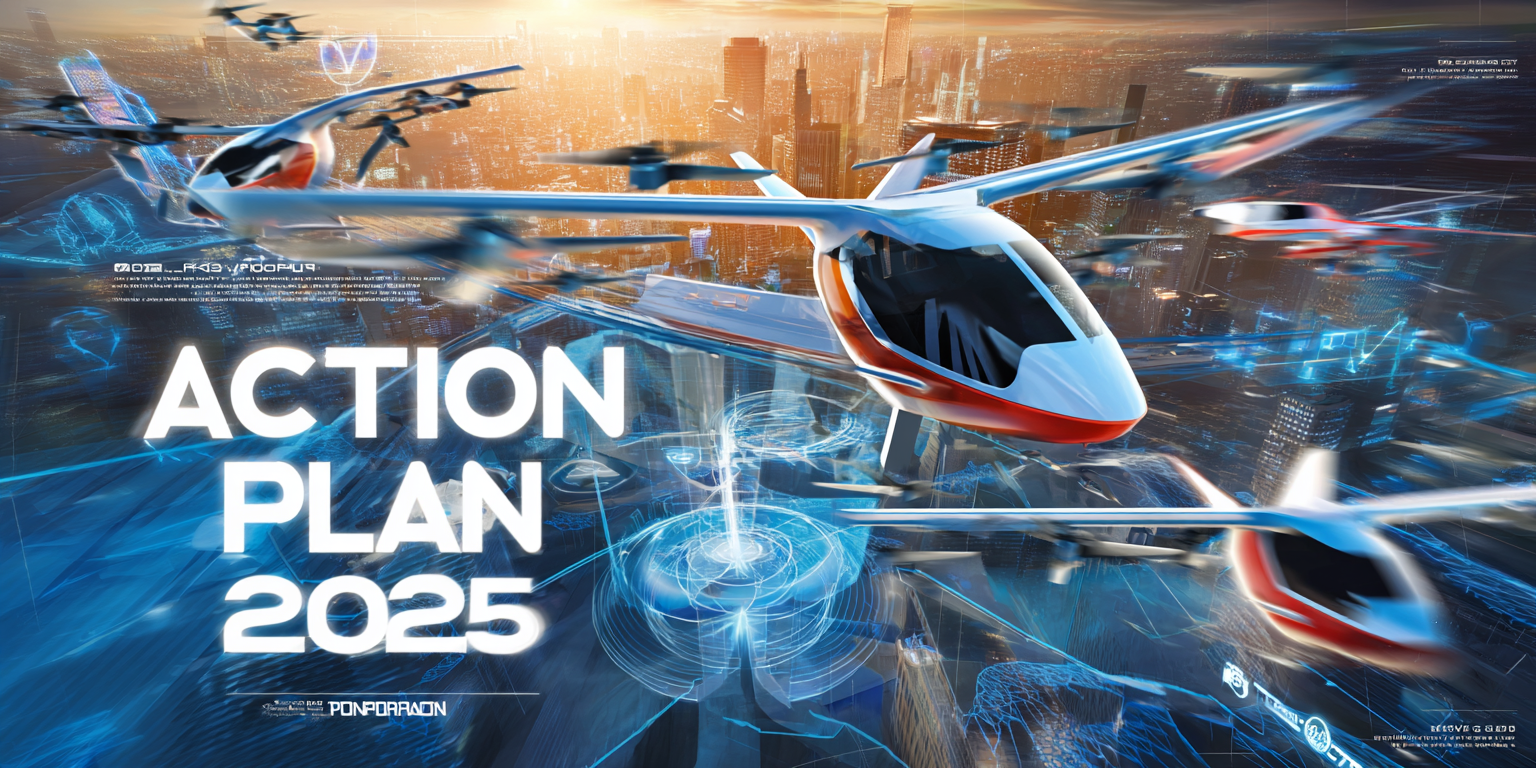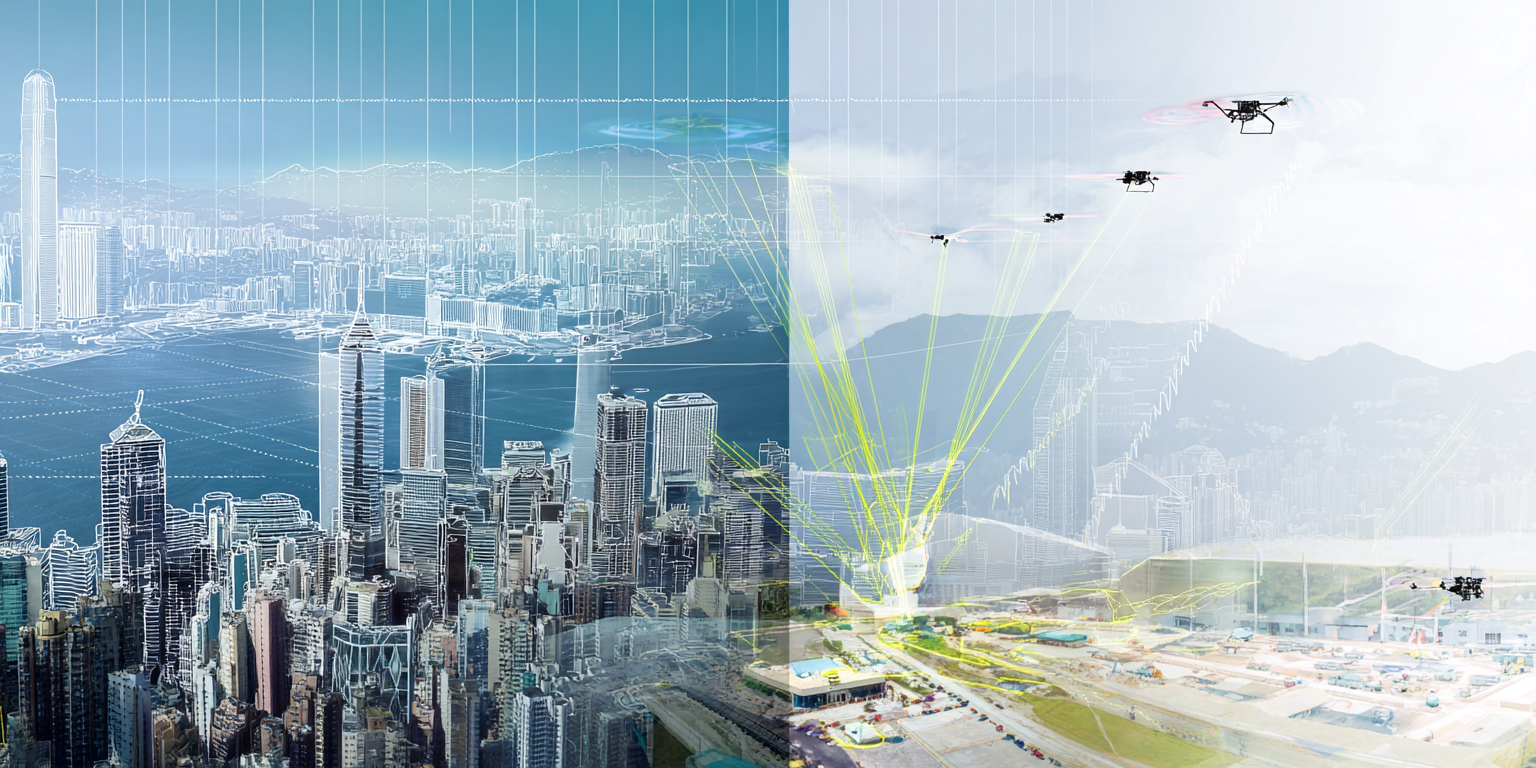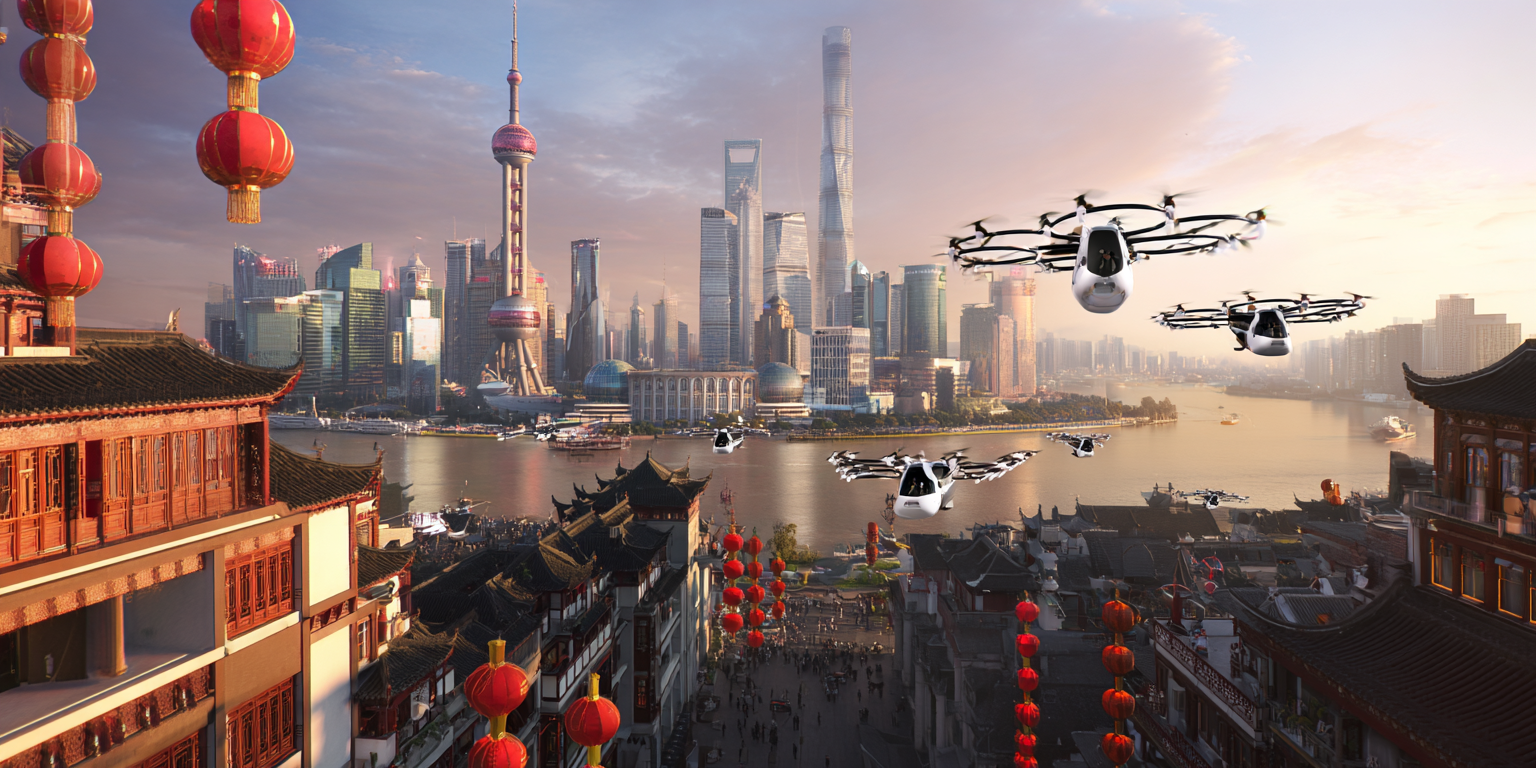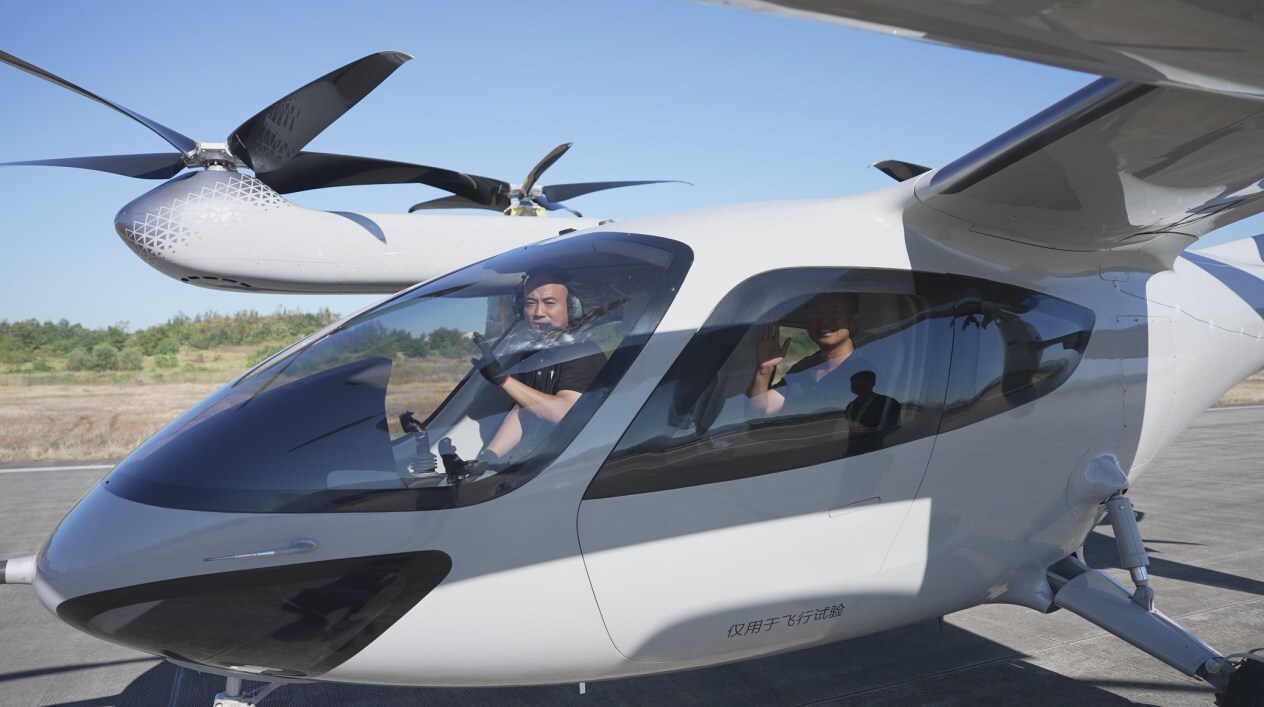The term "low-altitude economy" originated in China and refers to the economic activities and industries centered around civil manned and unmanned aerial vehicles operating at low altitudes, typically below 1000 meters. This emerging sector encompasses various activities utilizing UAVs (Unmanned Aerial Vehicles), eVTOLs (electric Vertical Take-Off and Landing aircraft), and other low-altitude flying vehicles for various applications.
China has led the development of its low-altitude economy, with strong government support and a rapidly growing ecosystem of companies. Shenzhen is at the forefront, with around 1,500 companies in the sector achieving an output of 75 billion yuan in 2022. The city aims to have over 1,700 low-altitude economy enterprises with an output exceeding 100 billion yuan by 2025. Other leading regions in China include:
- Guangzhou: Offering subsidies for eligible projects and planning unmanned aerial tourist routes
- Shanghai: Supporting industry-academia-research integration and talent attraction
- Anhui Province: Leading airspace management reforms in the Yangtze River Delta region
- Hunan Province: The first to have 97 verified low-altitude routes for industrial applications
- The Jiangmen Low-Altitude Tourism Town project ordered 100 XPeng Aeroht eVTOLs, while Taiyuan City purchased 500 EHang EH-216 eVTOLs.
Global Competition and International Collaboration
While China leads in developing a comprehensive low-altitude economy ecosystem, several countries and regions are emerging as key players in the global landscape:
- United States: Home to leading eVTOL developers like Joby Aviation and drone delivery pioneers like Amazon Prime Air and Wing Aviation (Alphabet). The US has high potential, given its technological capabilities and market size. The Federal Aviation Administration issued eVTOL airworthiness guidelines in 2023, signaling regulatory support. US companies are competing fiercely in the global eVTOL market. However, the US-China rivalry and expanding US tech restrictions on China could limit the US industry's growth prospects.
- Europe: A thriving ecosystem of eVTOL startups, including Volocopter and Lilium, with support from Airbus and Rolls-Royce; EASA is actively developing regulations for eVTOL certification and operations
- Germany: Germany focuses on developing its low-altitude economy, particularly larger eVTOL aircraft for longer-distance transportation. The country's strong automotive and aerospace industries could be an asset. The European Union also introduced eVTOL policies in 2024, benefiting Germany.
- Japan: Japan is another country that is investing in low-altitude transportation. Its expertise in high-tech manufacturing and robotics could support the industry's growth. However, Japan may need to contend with competition from China in the Asia-Pacific market.
- United Kingdom: The UK has a growing drone industry is working on an eVTOL-friendly regulatory framework. With companies like Rolls-Royce involved in eVTOL, its strong aerospace sector could drive growth. However, the UK market size is relatively small compared to the US and China.
- Emerging markets: Brazil's Embraer spinning off eVTOL unit Eve Urban Air Mobility Solutions; Indian drone startups attracting global investment
International collaboration is becoming increasingly important to advance the industry worldwide. Initiatives like the Joint Authorities for Rulemaking on Unmanned Systems (JARUS) aim to recommend unified requirements for certifying and integrating unmanned aircraft systems (UAS).
China and the EU have established a dialogue on urban air mobility (UAM) and UAS to share best practices and align regulatory approaches.
The International Civil Aviation Organization (ICAO) has launched the UAS Advisory Group (UAS-AG) to develop guidance and recommend standards for UAS operations.
Key sector within the low-altitude economy:
Urban Air Mobility: Urban Air Mobility (UAM) involves using eVTOLs for passenger transport in urban environments. This sector aims to provide air taxi services that can alleviate ground traffic congestion and offer faster travel times within cities. Shenzhen in China has already debuted multiple air taxi routes, demonstrating this technology's feasibility and public acceptance.
- New York City, USA: Joby Aviation and BLADE Urban Air Mobility partnered to launch an intra-city air taxi service, connecting Manhattan with JFK Airport. The service demonstrated the potential for eVTOLs to reduce travel times and ease congestion in one of the world's busiest cities.
- Paris, France: Volocopter, in collaboration with Groupe ADP and RATP Group, conducted a series of eVTOL test flights in the Paris region. The flights showcased the feasibility of integrating eVTOL services into existing transportation networks and the potential to link major airports with city centers.
- Dubai, United Arab Emirates: Dubai has been at the forefront of adopting eVTOL technology, with the Dubai Roads and Transport Authority (RTA) collaborating with German company Volocopter to launch air taxi services. The city aims to have 25% of all transportation trips be autonomous by 2030, with eVTOLs playing a significant role.
- Shenzhen, China: Multiple air taxi routes have been debuted, demonstrating the feasibility and public acceptance of eVTOL technology for urban passenger transport.
- São Paulo, Brazil: The Voom UAM demonstration program operated for four years, providing urban air mobility services using helicopters. Over 15,000 passengers were flown, showcasing the feasibility of air taxis in reducing urban congestion.
Logistics: Drone delivery for logistics is another critical component of the low-altitude economy. This includes same-city and cross-city transport of goods, which can significantly reduce delivery times and costs. Major companies like Amazon and DHL are already experimenting with drone delivery systems.
- Amazon Prime Air: Amazon is testing its MK27 delivery drone, which can carry packages up to 5 pounds within a 7.5-mile range. The drone uses sense-and-avoid technology to navigate safely.
- DHL: DHL has been testing its Parcelcopter drone delivery system in Germany and has completed several trials.
- Wing (Alphabet): Wing, a subsidiary of Google's parent company, Alphabet, operates drone delivery services in Australia, Finland, and the US. Its drones can carry packages up to 3.3 pounds over a 6-mile range.
- UPS Flight Forward: UPS has partnered with Matternet to deliver medical supplies via drones. The M2 quadcopter can carry payloads up to 5 lbs with a range of 12.5 miles.
- FedEx: FedEx is collaborating with Elroy Air to develop the Chaparral autonomous cargo aircraft. This hybrid-electric VTOL can carry 300-500 pounds of cargo up to 300 miles.
- SF Express: Chinese delivery giant SF Express is testing large cargo drones in Yunnan province. The FH-98 drone has a payload capacity of 1.5 tons and a range of 1,200 km.
Tourism: Low-altitude tourism involves using drones and eVTOLs for aerial sightseeing and providing unique tourism experiences. This sector can offer breathtaking views and immersive experiences that are otherwise inaccessible.
- EHang's EH216-S eVTOL: EHang, a Chinese company, has been using its EH216-S eVTOL for passenger-carrying sightseeing tours in scenic areas like Landing Lake in China.
- Volocopter's VoloCity: Volocopter, a German company, has been offering eVTOL tourism services in Singapore, giving passengers a unique perspective on the city-state's skyline.
- Joby Aviation's eVTOL: Joby Aviation, a US-based company, has been testing its eVTOL aircraft for tourism purposes in various locations, including the Grand Canyon.
eVTOL tourism offers a unique and thrilling way to experience scenic areas. It provides passengers with a bird' s-eye view of the landscape while also increasing accessibility to remote areas that are inaccessible by traditional means, making it possible for tourists to experience previously unexplored destinations.
Agriculture: In agriculture, drones are used for crop monitoring, spraying, and precision agriculture. These applications can improve crop yields, reduce chemicals, and optimize resource usage. Drones equipped with sensors can provide real-time data on crop health, soil conditions, and pest infestations, enabling farmers to make informed decisions.
This technology is particularly beneficial in large-scale farming operations where manual monitoring is impractical.
Surveillance and Inspection: Drones are increasingly used for infrastructure monitoring, security, and emergency services. They can inspect hard-to-reach areas, monitor large infrastructures like bridges and pipelines, and provide real-time data during emergencies. This capability enhances safety, reduces inspection costs, and allows for quicker response times in critical situations.
Public Safety: Integrating drones into public safety operations has significantly enhanced the capabilities of emergency responders and law enforcement agencies. Two notable examples illustrate the diverse applications and collaborative efforts driving this innovation:
Los Angeles Fire Department: The department utilizes a fleet of drones for various missions, including risk assessment, disaster response, and investigative operations. These drones play a crucial role in hazardous materials incidents, urban search and rescue missions, and swift water rescues, providing real-time data and aerial perspectives that improve situational awareness and operational efficiency.
Hidden Level and Joby Aviation: This collaboration focuses on developing scalable airspace operations using advanced sensor data to manage drone traffic. Hidden Level's Airspace Monitoring Service (AMS) analyzes real-time sensor data to track drone movements, ensuring safe take-off and landing at vertiports in densely populated urban settings. This partnership aims to enhance the integration of unmanned systems into low-altitude airspace, improving traffic management and operational safety.
Key Industries and Technological Innovations
Various industries and key players, including drone manufacturers like DJI, eVTOL developers such as XPeng Aeroht and EHang, and traditional aerospace giants, drive the growth of the low-altitude economy. These companies are leveraging cutting-edge technologies to enable UAVs and eVTOL aircraft to operate safely and efficiently:
eVTOL Manufacturers (USA): Joby Aviation, Archer Aviation, and Wisk Aero are developing eVTOL aircraft for urban air mobility. These California-based startups have attracted significant investment and are working towards certification and commercialization in the mid-2020s.
eVTOL Manufacturers (Europe): Germany's Volocopter and Lilium are leading European eVTOL developers. Volocopter has conducted public test flights and is working to launch commercial services, while Lilium is developing a regional air mobility network using its 7-seater Lilium Jet.
Traditional Aerospace: Airbus is actively involved in the eVTOL space with its CityAirbus NextGen aircraft and invests in electric and hybrid-electric technologies to enable sustainable aviation.
Drone Manufacturers: DJI is a major player in the drone industry, providing platforms for various low-altitude applications, such as aerial photography, mapping, and inspection.
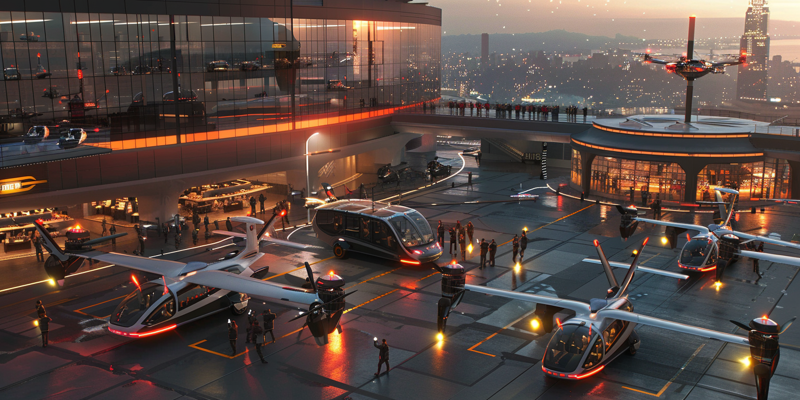
Vertiports: The Backbone of AAM Infrastructure
Vertiports are a crucial component of the Advanced Air Mobility (AAM) ecosystem, serving as hubs for eVTOL takeoff, landing, charging, and maintenance. These infrastructure nodes enable efficient, safe, and scalable AAM operations. As the AAM industry continues to grow, the importance of vertiports in supporting the increasing demand for eVTOL services cannot be overstated.
Several cities worldwide actively invest in vertiport development, recognizing these infrastructure nodes' critical role in unlocking AAM's full potential. Some notable examples include:
- United States: The FAA has been actively involved in developing vertiport infrastructure. In Orlando, Florida, Lilium has partnered with the city to develop a vertiport network that will serve as a model for future urban air mobility infrastructure.
- Europe: In the UK, Urban-Air Port has launched the world's first fully operational vertiport in Coventry. This vertiport, named Air-One, aims to demonstrate the feasibility of integrating UAM into urban environments and serves as a prototype for future vertiports worldwide.
- Middle East: Dubai is leading the charge with its ambitious plans for vertiport deployment. The Dubai Roads and Transport Authority (RTA) has partnered with Volocopter to develop vertiports across the city, aiming to integrate eVTOL services into its transportation network by 2030.
- Los Angeles, USA: The city has announced plans to develop a network of vertiports, with the first location expected to be operational by 2025. The vertiport will serve as a hub for eVTOLs, providing access to the city's downtown area and major transportation hubs.
- Singapore: The city-state has launched a vertiport development program to establish a network of vertiports to support AAM operations. The first vertiport is expected to be operational by 2026.
- Paris, France: The city has announced plans to develop a vertiport at the Charles de Gaulle Airport, which will serve as a hub for eVTOLs and provide access to the city center.
- Shenzhen, China: The city has already established a network of vertiports, with several locations operational and more in development. Shenzhen's vertiports are designed to support various AAM services, including passenger transport, cargo delivery, and medical transport.
-
Technological Innovations in the Low-Altitude Economy
Technological innovations are driving the growth of the low-altitude economy, improving the performance, safety, and efficiency of UAVs, eVTOLs, and the supporting infrastructure. Key advancements include:
- Vertiport Operating Systems: Advanced systems for automated resource management, predictive maintenance, energy management, and passenger processing enable safe and efficient Vertiport operations.
- Vehicle Technologies: AI, machine learning, advanced sensors, lightweight materials, and distributed electric propulsion enhance the capabilities and performance of drones and eVTOLs.
- Flight and Navigation Aids: Instrument landing systems, microwave landing systems, surveillance sensors, and situational awareness displays ensure safe eVTOL operations in urban environments.
- Unmanned Traffic Management (UTM): UTM systems provide airspace management, separation assurance, remote identification, and constraint management to enable safe and efficient low-altitude operations at scale.
- Connectivity Infrastructure: 5G networks, satellite links, and edge computing offer the high-bandwidth, low-latency connectivity critical for UTM and vehicle-to-vehicle coordination.
Integrating these technological advancements across vehicle design, vertiport infrastructure, traffic management software, and communication networks is essential for realizing the transformative potential of urban air mobility and drone logistics.
Regulatory Developments and Challenges
Integrating unmanned traffic management (UTM) systems for drones and urban air mobility (UAM) operations into existing air traffic management (ATM) frameworks poses several challenges:
- Developing new airspace classification schemes and procedures for visual line-of-sight (VLOS) and beyond visual line-of-sight (BVLOS) drone/UAM operations
- Establishing roles, responsibilities, and interfaces between UTM/UAM services and traditional air traffic control (ATC)
- Defining communication, navigation, and surveillance (CNS) requirements compatible with existing ATM systems while meeting higher reliability needs
Governments worldwide are developing comprehensive regulatory frameworks to address these challenges and govern low-altitude airspace operations. These efforts aim to facilitate commercial applications, unlock airspace access, address safety and public concerns, and guide infrastructure planning and development.
In the United States, the Federal Aviation Administration (FAA) Reauthorization Act of 2024 has significant implications for drone operations near airports, secure sites, and critical infrastructure. Key provisions include:
- Establishing a new Unmanned and Autonomous Flight Advisory Committee to advise the FAA on policy and technical issues
- Extending the BEYOND Program to address increasing automation in civil aircraft and BVLOS operations
- Developing a comprehensive plan for integrating autonomous UAS into the national airspace
- Publishing a BVLOS notice of proposed rulemaking within four months and a final rule within 16 months
Shenzhen has unveiled regulations for promoting the low-altitude economy in China, marking the country's first dedicated legal framework to foster this emerging sector. The regulations address issues such as airspace management, safety standards, and operational guidelines for UAVs and eVTOLs.
These regulatory developments are crucial for establishing harmonized standards to enable cross-border operations and advance the industry globally.
Career Opportunities in the Low-Altitude Economy
The low-altitude economy, spurred by advancements in UAVs (Unmanned Aerial Vehicles) and eVTOLs (electric Vertical Take-Off and Landing aircraft), is creating new career paths and reshaping existing ones. This sector offers diverse opportunities across various disciplines, including aerospace engineering, urban planning, data analysis, and regulatory affairs. Understanding the skills and qualifications needed to thrive in this innovative landscape is essential.
Key Advanced Air Mobility (AAM) Career Opportunities:
UAV and Drone Pilots: Operate UAVs for aerial photography, surveying, delivery, and inspection.
eVTOL Pilots: Operate eVTOLs for urban air mobility services like air taxis.
Engineers and Technicians: Design, develop, and maintain UAVs and eVTOLs, focusing on aerodynamics, propulsion, avionics, and materials.
Data Analysts and IT Specialists: Manage data generated by UAVs and eVTOLs to optimize operations and ensure safety.
The low-altitude economy promises dynamic career opportunities, making it an exciting field for professionals with the right skills and qualifications.
Challenges and Future Prospects
Despite the promising advances in the low-altitude economy, several challenges need to be addressed:
- Safety and Accidents: Operational concerns regarding safety and potential accidents continue to overshadow the development of the low-altitude economy. Stringent safety standards and robust regulatory frameworks are essential to ensure public trust and acceptance.
- Cost: High prices for eVTOL aircraft and drone services currently limit widespread adoption. Technological advancements and economies of scale are expected to reduce costs over time.
- Infrastructure: Developing vertiports, charging stations, and UTM systems is crucial for supporting large-scale low-altitude operations.
- Public Acceptance: Addressing noise, privacy, and visual pollution concerns will be essential for gaining public support for low-altitude operations in urban areas.
- Technological Limitations: To enhance the safety and efficiency of low-altitude vehicles, improvements in battery technology, autonomous flight systems, and collision avoidance capabilities are needed.
The low-altitude economy is expected to create diverse job opportunities across engineering, operations, data analysis, maintenance, regulatory affairs, urban planning, logistics, and more. The demand for professionals with interdisciplinary skills, combining aviation, robotics, and data science expertise, will likely increase significantly.
The low-altitude economy is poised to revolutionize urban transportation, logistics, tourism, and various industries, driven by advancements in UAVs, eVTOLs, and supporting infrastructure.
As regulatory frameworks evolve and global collaboration intensifies, the successful integration of low-altitude operations into existing airspace management systems and urban environments will require continued innovation, adaptation, and public engagement.
With China leading the development of a comprehensive ecosystem and significant progress in other regions, the low-altitude economy is set to play a pivotal role in shaping the future of commerce, mobility, and urban life worldwide.


